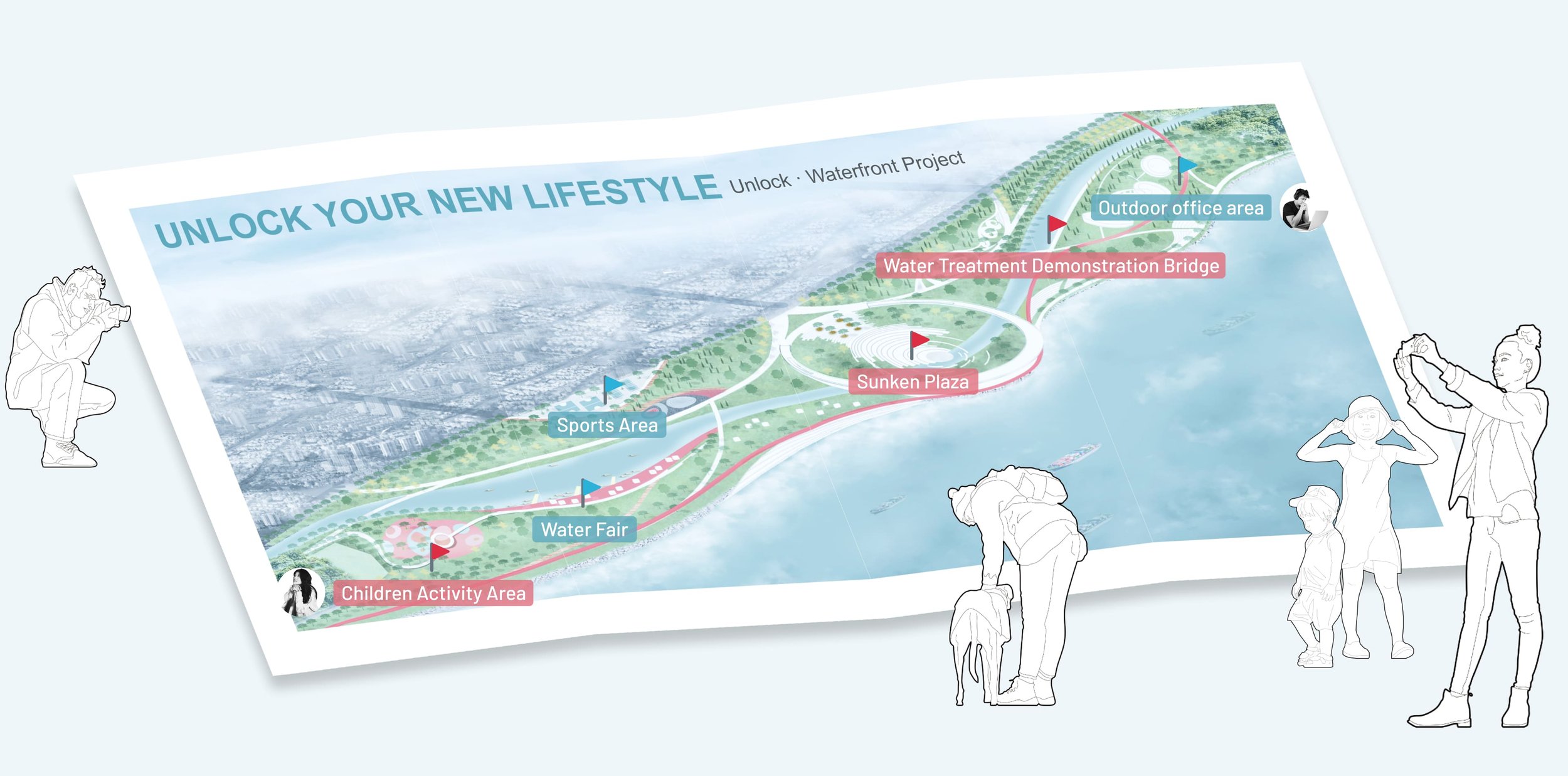
CONTEXT
2021.9-2021.12
Team Project
MY ROLE
Research
Landscape Design
TOOLS USED
Auto CAD
SketchUp
Figma
Adobe Photoshop
OVERVIEW
This is a landscape design project. It focuses on creating a public leisure space for unmarried office workers and homemakers living in Zizhu High-tech Industrial Park in Shanghai. After thoroughly investigating the physical site and user requirements, our team designed a relaxing and enjoyable outdoor experience for these two groups of people.
PROCESS
SITE ANALYSIS
Science + Education = Site Features!
The site of this project is located in Zizhu High-tech Industrial Park, Minhang District in Shanghai. To the south, there are Shanghai Jiaotong University, East China Normal University, as well as many other high-tech company campuses. According to the future urban planning, the southern part of the site is planned for use of education, scientific research, and residence.
Research
COMPETIVE ANALYSIS
Let the missing functions in other projects turn into highlights in this site
I compared features of other three waterfronts along the Huangpu River, and then I found that the hydrophilic function and the educational function are the two most important missing functions. Thus, I decided to emphasize these two in this site in order to let this waterfront have its own distinguished features.
USER SURVEY
According to field surveys and questionnaires, people aged 15-59 are the main users, and they usually travel with 2-4 people. In terms of choice of travel activities, stress-relieving activities and sports and fitness have become the main choices of people, but the existing surrounding landscapes generally have the problem of single function, which is far from the landscape expected by users.
PERSONA
One is hard-working single, another is family-oriented married one
According to the previous questionnaire and the future planning of the surrounding plots, I divided the main users into two categories: one is the single family with hard work represented by Wang Ning, who work in research institutes and technology companies around the base. The right problem is that the work pressure is high, and I hope to work in a relaxed and pleasant environment, there is no space for exercise at noon and no social opportunities after returning home from get off work; the other type corresponds to the family-oriented married living around the base. People, they come here largely because of the school district housing. Sun Siyu is a typical group of people who find that there is no rich playground for children around now. At the same time, families rarely have the opportunity to get close to nature. Their learning is also mostly textbook-based, with little opportunity for practice.

DESIGN CHALLENGE
Based on the results of the site analysis and user research, we summarize the design challenges as:
How might we help hard-working singles and family-focused marrieds unlock a relaxing and fun lifestyle?
Design
USER JOURNEY RESHAPING
Reshape the user journeys according to two types of pain points
On the basis of user portraits, I have sorted out the timelines and expectations of the two types of users' lives: taking a working day of a single family working hard for their careers as an example, I selected three life scenarios: work, lunch break, and after get off work. We concluded that we can design outdoor office areas, sports venues, and outdoor activity areas for them to meet their needs; and family-oriented married people represented by Sun Siyu have a more typical rest day life, mainly including children's play, For the three life scenarios of parent-child rest and parent-child education, we have designed three functions of children's play, contact with nature and popular science education to meet their needs.
LOW-FI (PLAN SKETCH)
Brainstorm road networks
According to the future planning of the surrounding plots, my team members and I drew four different road network types and inland rivers, and analyzed these four plans. After comparing the pros and cons of these four plans, we finally chose the third one to deepen our design.
STRUCTURE
Determine functional areas, view sight corridors and road functions
Based on the determined road network, we determined each functional area and adjusted the location of each functional area after determining the nature of the main roads and view corridors, and finally completed the design of the plan.
MID-FI (MODEL)
Advance the in-depth design of landscape nodes and build the model
After the preliminary plan was determined, the team members and I carried out detailed design for each area, adding refined designs for pavement, structures, installations, height differences, etc.. Finally, we built a model.
Outcome
HIGH-FI (RENDERING)
Let us unlock your relaxing and fun lifestyle together!
After that, we drew a bird's-eye view on the basis of the white mold, distinguished different materials and designed the planting. We also selected the main functional areas to draw the node perspective. The functional areas can bringing color and vitality to users’ lives. The whole experience was completed! Let us get started!
Reflection
DIFFICULTIES I MET
Although the design process of UX design and landscape design is roughly the same, including preliminary research, brainstorming and deepening design, UX design corresponds to a smaller design scope and requires a rigorous logical derivation of design decision, so this change of thinking brings me a considerable challenge.
THINGS I LEARNED
The landscape is not modified in the design phase through user testing of the solution, which may lead to a design that runs counter to the user's expectations, while the positioning of the design has to be considered from a more macro planning level, while ux design allows for quick modifications to the design in response to user feedback and from a smaller perspective, the user's perspective, to make subtle modifications. The previous study of landscape design laid a certain foundation for my design thinking, thus allowing me to better understand the importance of design challenge definition in ux design and the significance of iterative design based on user testing.


















